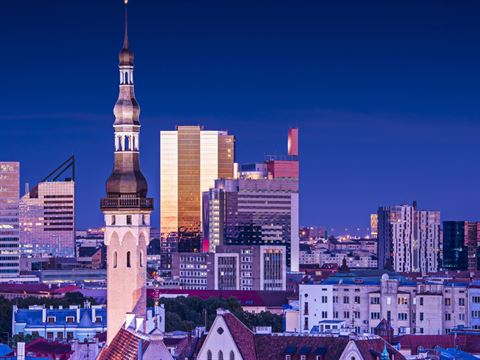Destinations • May 2014
The changing face of the Eastern Bloc
Twenty-five years on from the fall of Communism, many of the once gloomy cities of Eastern Europe have become exciting destinations for travellers. Budapest-born author Victor Sebestyen takes a look at five success stories from the region, and suggests five other up-and-coming spots to visit before the crowds set in
Prague: 5.8 million visitors
A quarter of a century ago, you could be alone as you crossed the beautiful Charles Bridge in a city that was visibly a front in the Cold War. In 2012, Prague attracted 5.8 million foreign tourists, compared to a few thousand in 1989. Where there were once queues to buy meat or fresh veg, nowadays, you’ll find people lining up to visit the city’s fine baroque palaces.
Don’t miss: The Museum of Communism, in Na Prikope street, downtown Prague, which, amusingly, shares a building with a casino.
Berlin: 4.4 million visitors
When the Wall still stood, Berlin consisted of two ugly, dull and provincial towns. It has since been transformed into one vibrant city – arguably one of the most exciting in mainland Europe. Last year, 4.4 million foreign tourists explored Berlin’s rebirth, achieved through clever urban planning and the loving restoration of the old.
Don’t miss: A walk by the river Spree near the charming Weidendammer Bridge.
Budapest: 2.8 million visitors
In the days of Communism, Hungary was relatively relaxed, often labelled the ‘merriest barracks in the camp’. Budapest still knows how to enjoy itself, as its 2.8 million tourists last year can attest. From high on the Buda side of the river, as the Danube sweeps around a gentle bend below, is one of the loveliest urban views in the world – and some of the tastiest restaurants.
Don’t miss: Taking a reflective pause away from the crowds at Gül Baba, a Turkish pasha’s shrine, on Rózsadomb, overlooking the river.

Pulling power: Krakow’s baroque old town attracts more visitors than the Polish capital, Warsaw
Krakow: 2.3 million visitors
Most Polish cities were destroyed in World War II, but Krakow was almost undamaged. Its baroque heart is very nearly as the Habsburgs left it a century ago. Around 2.3 million tourists visited in 2012 – a third more than went to Poland’s capital, Warsaw, but it’s also a place of religious pilgrimage and of homage to classic Mitteleuropa (the German term for Central Europe).
Don’t miss: The small market square in the old town near St Mary’s Basilica, which the crowds often miss in favour of the main square.
Bucharest: 1.5 million visitors
Romania took a long time to recover from the dictatorship of Nicolae Ceausescu. Once known as The Little Paris of the East, Bucharest welcomes 1.5 million tourists a year. The bustling, thriving and gutsy metropolis has a vibrant art scene and an unmistakable Balkan flavour.
Don’t miss: A stroll through Cismigiu Gardens, off the beaten track but close to the hubbub at University Square.

On the up: part medieval, part modern, Tallinn is definitely post Soviet
The new kids on the bloc
Tallinn
Estonia has changed more than any of the other Baltic States since independence from the former USSR. It has more visibly shrugged off the Communist years than the others, where the near past seems to hang more heavily. Tallinn is part medieval, part modern, but completely post-Soviet. From a few hundred visitors before 1991, it had about 1.5 million last year, and is one of Europe’s most unspoilt old seaports.
Dresden
When Dresden was carpet-bombed in World War II, an important stopping point in the Grand Tour and one of the marvels of Europe disappeared. Part of East Germany, it was left to rot for 40 years. Rebuilt since the German reunification, visitor numbers have more than doubled in the last five years to around 1.8 million.
Varna
Many investors lost money when the bubble burst in the Black Sea property market after 2008. However, the upside of such turmoil was that rampant development, which ruined much of the Bulgarian coast, ceased. Now there are miles of wild places and lovely beaches, unspoilt by concrete.
Cluj
Three hours from Bucharest, Cluj is the main city of Transylvania. Even the ghastly years under Ceausescu barely touched its medieval surface. It still attracts relatively few visitors – under 500,000 in 2012 – but tourism is growing by five per cent a year. The real Vlad Dracula castle is nearby, and so is some landscape that shows what Europe once looked like before the forests were destroyed – home to dozens of species of birds and other wildlife extinct elsewhere in Europe.
Karlovy Vary
As Carlsbad, it was the most fashionable spa town in central Europe, where tsars, jaded aristocrats and composers from Mahler to Beethoven took the medicinal waters. Now this Czech town, long a byword for faded grandeur, has had a makeover. Belle Epoque and new hotels are giving a modern twist to the old idea of a spa holiday.
Victor Sebestyen is the author of Revolution 1989: The Fall of the Soviet Empire
This article has been tagged Opinion, Destination
